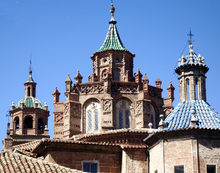Teruel Cathedral
The Cathedral of Teruel has its origins in the church of Santa María de Mediavilla, upon which work started in Romanesque style in 1171 and ended with the erection of the Mudéjar tower in 1257.
In the second half of the 13th century, the Morisco alarife Juzaff restructured the old Romanesque work and endowed the building with three Mudéjar naves of masonry and brick.
In 1423, the Aragonese pontiff Antipope Benedict XIII, the so-called "Pope Luna," raised it to the rank of a collegiate church.
These diverse human types and extensive variety in pictorial imagery are well preserved because they were covered by a false Neoclassical ceiling in the 18th century, which protected the paintings from inclement weather.
Likewise, the ornamentation was modified to adapt it to the Neoclassical tastes, hiding behind the false ceiling of the 18th century, the original Mudéjar roof, which allowed the painting to be conserved.
In 1909, the enormous historicist southern façade was constructed, which combines a Neo-Romanesque structure of semicircular archivolts with a typically neo-Mudéjar decoration.
The portico closes with an iron gate by Matías Abad, which was inspired by the choir inside the cathedral, made by the 15th century master Cañamache.
[1] According to the declaration: The development in the 12th century of Mudejar art in Aragon resulted from the particular political, social and cultural conditions that prevailed in Spain after the Reconquista.



